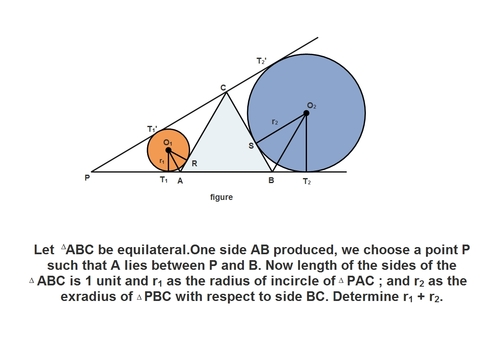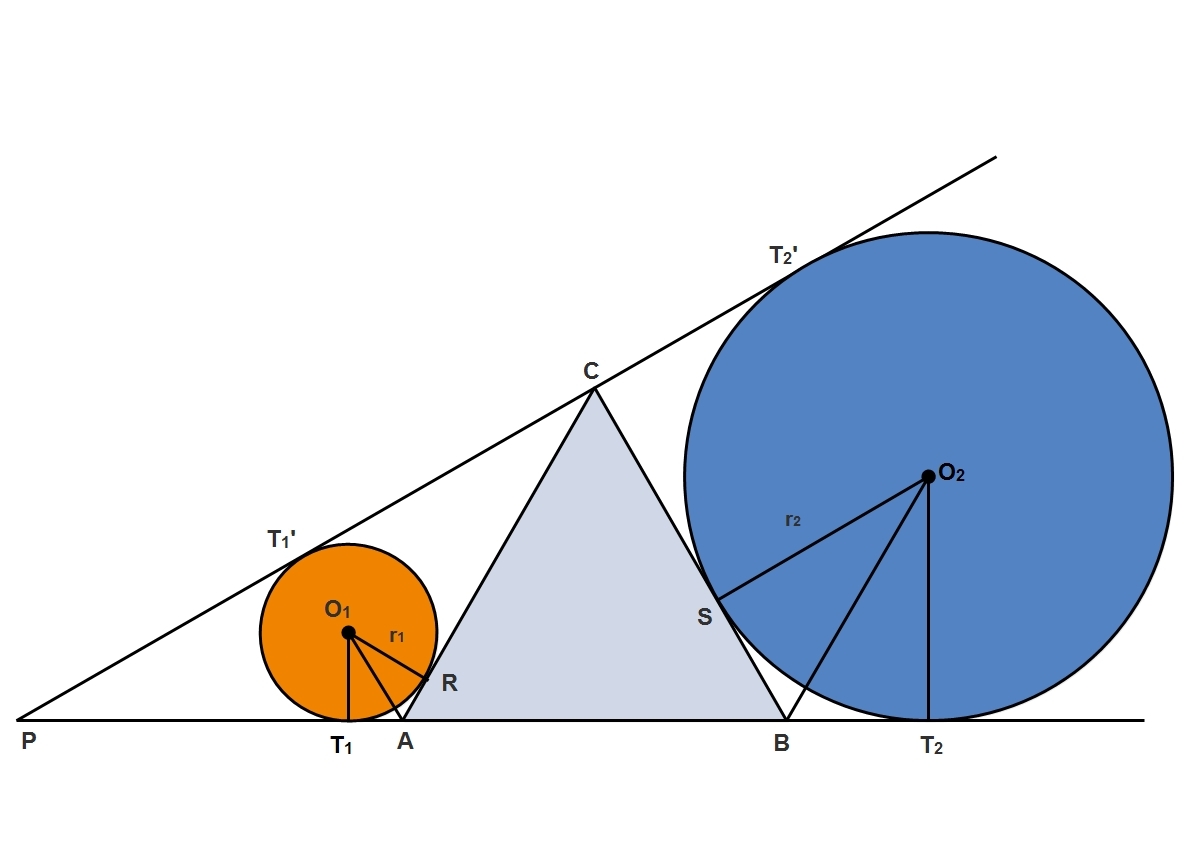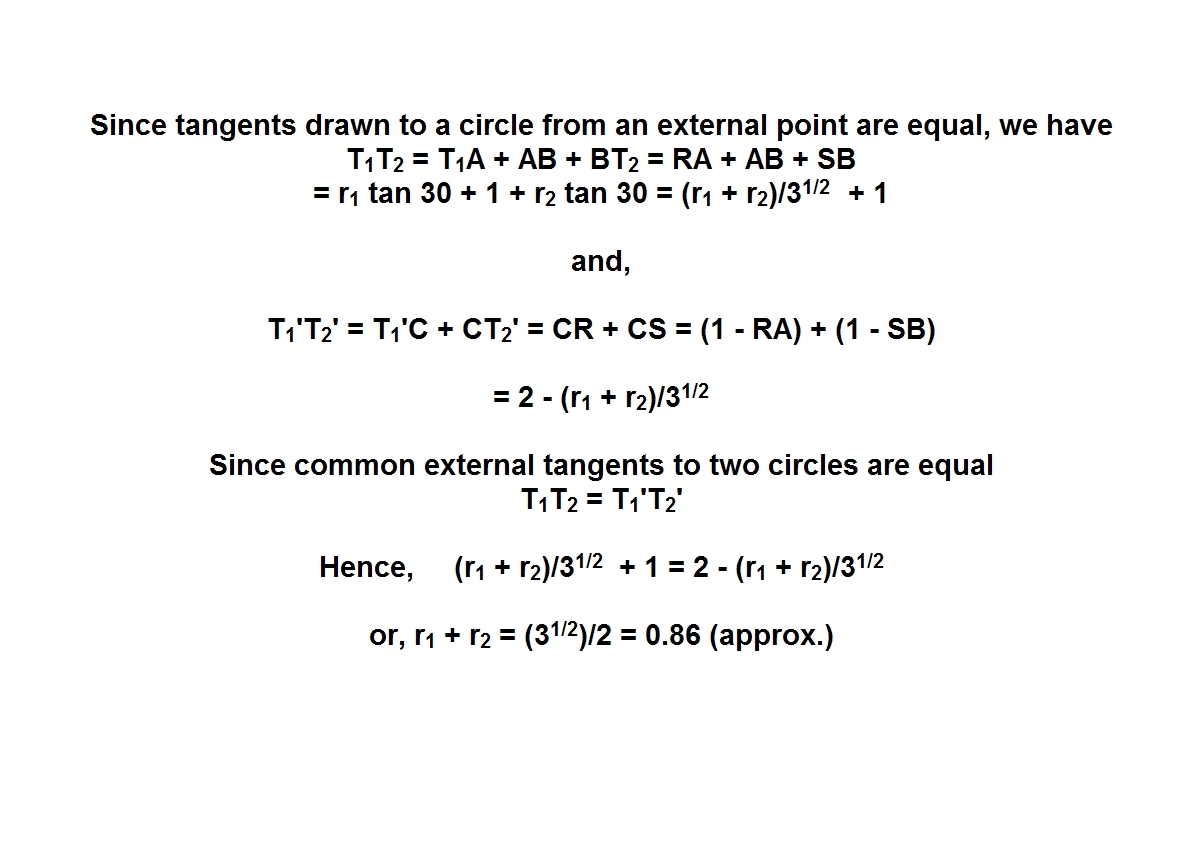This section requires Javascript.
You are seeing this because something didn't load right. We suggest you, (a) try
refreshing the page, (b) enabling javascript if it is disabled on your browser and,
finally, (c)
loading the
non-javascript version of this page
. We're sorry about the hassle.
2 solutions
1) Open MS Paint.
2) Measure the radii, add them together, and divide it by the triangle's side length.
(just kidding, but neat problem! I have not seen this particular relation before.)
Join AO1. Drop a perpendicular from C to AB to meet at H. This is the altitude of the equilateral triangle ABC
Now consider the Triangle AT'1C .
As we know Angle CAP = 120 degrees, Angle ACT' = 60 ( As O1 is incenter) So , Angle ACT' = 30 degress.
Therefore the triangel APC is isosceles with AC =1 and AP =1. Applying law of sines, the length of PC = Sqrt(3)
The Semi-perimeter "S" of Triangle APC = (2+sqrt(3))/2
Area = S R1 (Semi perimeter multiplied with Radius of incircle) Also the area of triangle APC = 0.5 (base PA) (Height of Equilateral triange) => S R1 = 0.5 1 Sqrt(3)/2 On Solving we get R1 = 0.232 --------------------- (1)
Now consider the angle BCT'2 . The Angle is 90 Degress, suggesting that the quadrilateral CSO2T'2 is a square with side of length R2,
Therefore CS = R2 and SB = 1 - R2
Also, the Angle T'2O2T2 is 150 degrees ( Since Angle P is 30 Degrees)
suggesting the Angle SO2T2 will be 60 Degrees.
Therefore the Angle SO2B will be 30 Degrees and the triangles SO2B and HCB are similar
=> O2S / SB = CH / HB => (R2)/(1-R2) = ( Sqrt(3)/2 ) / (1/2)
On solving R2 = 0.633 ------------------------------ (2)
Therefore R1+R2 = 0.232 + 0.633 = 0.865
"Angle ACT' = 60 ( As O1 is incenter) So , Angle ACT' = 30 degress."
Please explain. There is some typo?
O 1 T 1 ′ = r 1 . I n Δ s T 1 ′ P O 1 a n d T 1 P O 1 , O 1 T 1 ′ = O 1 T 1 , T 1 ′ P = T 1 P e q u a l t a n g e n t l e n g t h , O 1 P c o m m o n . ∠ T 1 ′ O 1 T 1 = 1 5 0 s o ∠ T 1 ′ P T 1 = 3 0 , ⟹ A C T 1 ′ = 3 0 . ⟹ P A = A C = 1 . I n Δ P A C , U s i n g S i n L a w , P C = S i n 1 2 0 ∗ A C / S i n 3 0 = 3 . A s p e r n o r m a l f o r m u l i i , A r e a Δ P A C = . 5 ∗ 1 ∗ 1 ∗ S i n 1 2 0 = 4 3 . A r e a Δ P B C = . 5 ∗ 1 ∗ 1 ∗ S i n 1 2 0 + 4 3 ∗ 1 2 = 2 3 . S 1 = . 5 ∗ ( 1 + 1 + 3 ) . S 2 = . 5 ∗ ( 2 + 1 + 3 ) . ∴ r 1 + r 2 = . 5 ∗ ( 2 + 3 ) 4 3 + . 5 ∗ ( 3 + 3 ) − 1 2 3 . = 0 . 8 6 6 2 5 .


